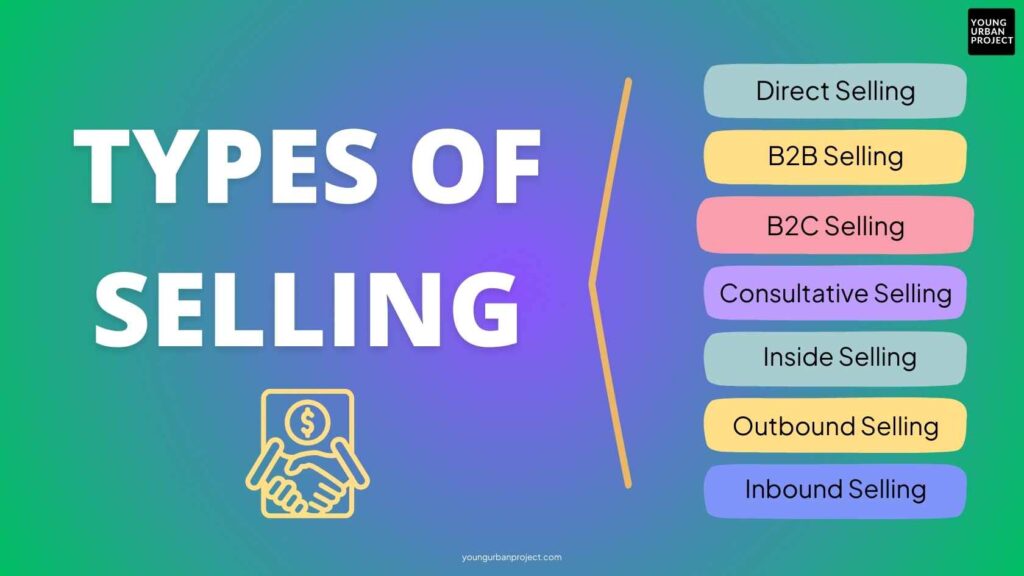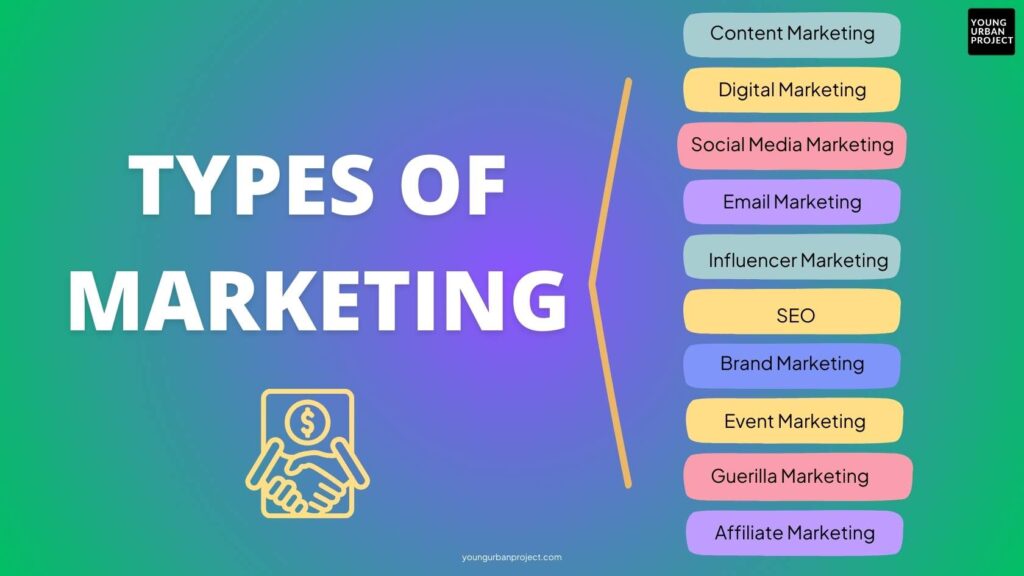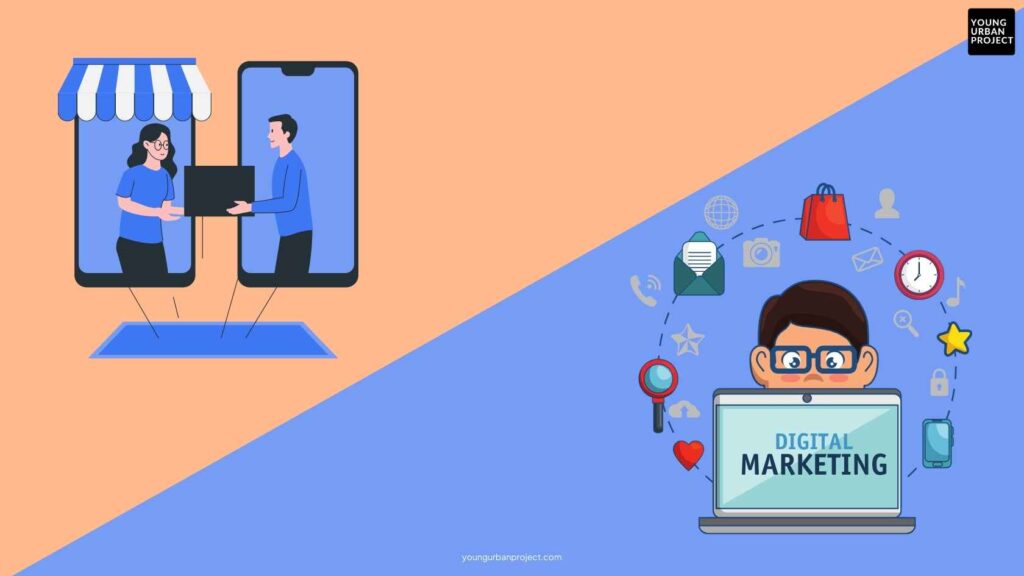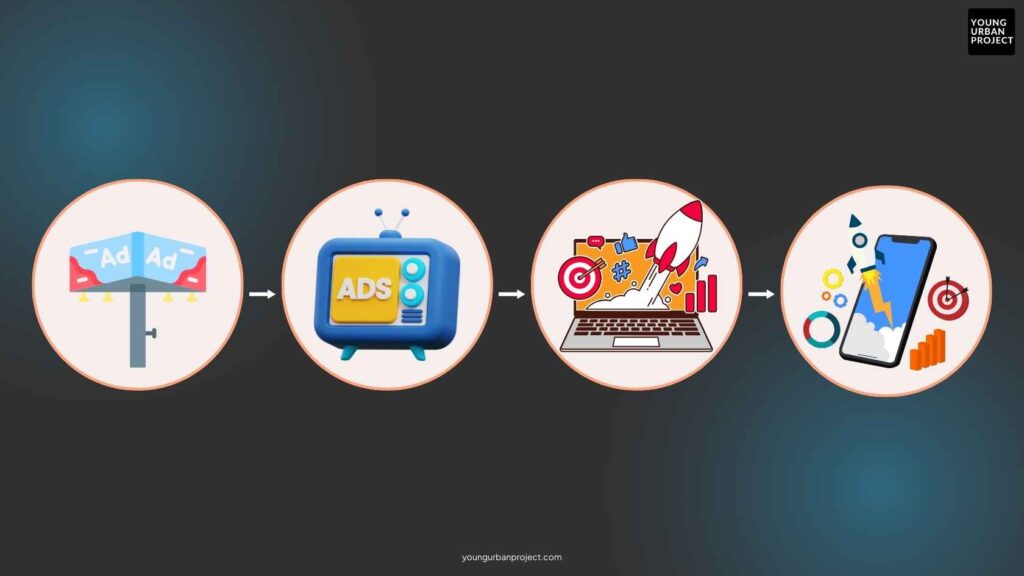Understanding the difference between selling and marketing is important for organizations striving for growth and success today. But many people get confused about them.
While both are integral components of a business strategy, they serve distinct purposes and employ different techniques. This article explores these differences in detail, highlighting the significance of each function in achieving business objectives.
Table of Contents
Why Understanding the Difference Between Selling and Marketing is Important
We’ve all been sold something we didn’t need. And we’ve all been marketed to in ways that made us feel like part of something bigger. The distinction may seem subtle, but it’s massive. Selling is often seen as a transaction or a one-time exchange. Marketing, on the other hand, is a relationship, a strategy that spans the entire customer journey.
Recognizing the difference between selling and marketing is crucial for both professionals and businesses striving for long-term success. While these two functions may seem like they overlap, they serve distinct roles, and understanding their uniqueness can unlock significant advantages.
1. Personalised Strategies for Growth
When businesses clearly differentiate between selling and marketing, they can craft more tailored strategies. Marketing sets the stage by identifying customer needs, building awareness, and creating interest in the product or service. Selling then steps in to convert that interest into actual revenue. Without recognizing these distinct roles, businesses might end up under or over-investing in one area, which can hinder growth.
For instance, a company may focus heavily on its salesforce to boost short-term revenue but neglect long-term marketing efforts like brand-building and customer relationship management. This might yield quick wins but can lead to stagnation in the future when a lack of brand recognition or customer loyalty causes sales to dip.
2. Effective Resource Allocation
Understanding the difference helps allocate resources efficiently. For example, a new product launch may require significant marketing spend on advertising, content creation, and social media engagement to generate awareness and interest. However, closing deals during the launch period might require increased investment in the sales team for direct customer interactions and final conversions.
Misunderstanding the roles can lead to poor resource allocation. If a company puts too much emphasis on sales without supporting it with marketing, sales teams may struggle to convert uninterested or unaware leads. On the other hand, overinvesting in marketing without an adequate sales strategy can lead to missed revenue opportunities.
3. Enhanced Customer Experience
Marketing and selling cater to different stages of the customer journey. Marketing builds the foundation by attracting prospects and nurturing them through brand touchpoints, while selling deals directly with converting prospects into customers. If these processes are blended or poorly coordinated, the customer experience can suffer.
For example, a customer might feel overwhelmed if they are contacted too soon by a salesperson before fully understanding the product through marketing materials. On the flip side, customers may lose interest if they are bombarded with marketing campaigns but never followed up with a personalized sales approach. Balancing these two ensures that customers feel guided, not pressured, and have a seamless journey from awareness to purchase.
Also read: Importance of Service Marketing
4. Optimized Communication and Messaging
Selling and marketing employ different communication methods. Marketing focuses on broadcasting messages to a wider audience, emphasizing brand storytelling and value propositions. Selling, however, involves more personalized, one-on-one communication aimed at addressing specific customer needs and closing the deal.
When businesses grasp the difference, they can ensure their communication strategies align with the right stage of the customer journey. For instance, a marketing email may introduce the benefits of a product broadly, while a sales call will dive into specifics, answering detailed questions that can push the prospect to purchase.
5. Stronger Collaboration Between Teams
In businesses where the marketing and sales teams are closely aligned, understanding the differences between the two functions fosters collaboration. Each team knows its role, and both work toward a common goal—revenue growth. Marketing can focus on generating qualified leads, while sales can focus on converting those leads into paying customers.
Misunderstandings between these teams can lead to friction, with marketing teams feeling that sales aren’t utilizing their leads effectively and sales teams feeling that marketing isn’t providing high-quality leads. When both teams understand their unique but complementary roles, they can collaborate more effectively, leading to better results.
6. Sustainable Business Growth
Finally, long-term success depends on a balanced approach. Selling can drive immediate results, but without consistent marketing efforts, sales pipelines may dry up. Marketing can create awareness and generate leads, but without an effective sales strategy, those leads might never convert into paying customers.
By fully understanding the difference between selling and marketing, businesses can create a sustainable growth model—one that doesn’t rely too heavily on one function while ignoring the other. This balanced approach allows companies to build lasting relationships with customers, grow their brand, and continue generating revenue well into the future.

What is Selling?
Selling is the process of convincing someone to buy a product or service. It focuses on guiding a customer through the sales funnel to make a purchase. A salesperson’s main goal is to close the deal, often using tactics to meet quotas or targets.
In traditional selling, the focus is mainly on the product, sometimes without considering whether the customer truly needs it. This is why you might feel pressured when a salesperson pushes too hard.
While this method works to some degree, there’s a limit to how much you can push. That’s where marketing plays a crucial role.
Types of Selling

Selling comes in various forms depending on the product, audience, and sales environment. Here are some common types:
1. Direct Selling
Direct selling involves face-to-face interaction with potential customers, usually outside of a traditional retail environment. This often includes door-to-door sales, one-on-one presentations, or even party-plan models where products are showcased in social settings.
2. B2B (Business-to-Business) Selling
B2B selling is the process of selling products or services from one business to another. This type of selling often involves high-value transactions, long sales cycles, and a personalized approach to closing deals.
Example: A software company sells enterprise-level cybersecurity solutions to other businesses. The sales team customizes the pitch to meet the specific needs of each business client.
3. B2C (Business-to-Consumer) Selling
B2C selling is focused on selling products or services directly to consumers. This is the most common form of selling, occurring in retail stores, online shopping platforms, and e-commerce websites. The emphasis is usually on quick conversions.
Example: A clothing brand sells fashion products to individual customers through an online store, using promotions and product descriptions to encourage purchases.
4. Consultative Selling
Consultative selling is about building a relationship with the customer by understanding their problems or needs and offering tailored solutions. It’s less about pushing a product and more about solving the customer’s pain points.
Example: A financial advisor talks to a client to understand their financial goals and then recommends specific investment products that meet their needs.
5. Inside Selling
Selling happens remotely, often over the phone or through digital channels. It doesn’t involve face-to-face interaction but relies on tools like email, video calls, or chat to engage with potential buyers.
6. Outbound Selling
In outbound selling, the salesperson initiates contact with potential customers, often through cold calls, emails, or ads. It’s a proactive approach to reaching out to leads who may not yet be familiar with the brand.
7. Inbound Selling
Inbound selling occurs when potential customers take the first step by contacting the company. Sales teams then engage these leads, answering questions and guiding them toward a purchase.
Also read: Scope of Marketing
What is Marketing?

Marketing is about opening a conversation, building awareness, and connecting with customers. Unlike selling, which focuses on closing a deal, marketing focuses on understanding customer needs, desires, and pain points. It’s not always about the product—sometimes it’s about creating stories, educating, and building loyalty.
For example, a strong marketing campaign can make customers excited about a product, like how Apple fans line up for a new iPhone even when their current one still works. That’s the power of marketing.
Types of Marketing
Marketing encompasses a wide range of strategies and tactics, each designed to engage different audiences and meet specific goals. Here are the most common types of marketing:
1. Content Marketing
Content marketing focuses on creating and distributing valuable, relevant content to attract and engage a target audience. This can take the form of blog posts, videos, infographics, or eBooks.
2. Digital Marketing
Digital marketing refers to any form of marketing done through digital channels such as websites, social media, email, and search engines. This approach allows for precise targeting and measurable results.
3. Social Media Marketing
Social media marketing leverages platforms like Facebook, Instagram, LinkedIn, and Twitter to promote products, engage with customers, and build brand awareness. It’s a powerful way to interact with a large audience.
4. Email Marketing
Email marketing involves sending targeted messages to a list of subscribers. It’s commonly used for lead nurturing, product promotion, and customer retention through personalized and timely emails.
5. Influencer Marketing
Influencer marketing involves partnering with influencers who have a large following to promote products or services. These influencers share their experiences with a brand, often driving purchase decisions among their audience.
6. SEO (Search Engine Optimization)
SEO focuses on improving a website’s visibility on search engines like Google. By optimizing content and keywords, businesses aim to appear higher in search results and attract organic traffic.
7. Brand Marketing
Brand marketing is focused on building a strong, positive perception of a brand over time. It’s more about creating emotional connections and recognition than driving immediate sales.
Example: Coca-Cola’s brand marketing consistently focuses on happiness, friendship, and togetherness, creating a lasting image in the minds of its consumers.
8. Event Marketing
Event marketing involves organizing or participating in events to promote a product or service. This can be online, like webinars, or offline, such as trade shows or conferences.
9. Guerilla Marketing
Guerilla marketing uses unconventional and low-cost tactics to create a strong impression on potential customers. It often relies on creativity and surprise.
Example: A sneaker brand installs 3D street art on a busy sidewalk, attracting pedestrians’ attention and generating buzz on social media.
10. Affiliate Marketing
Affiliate marketing allows other people or companies (affiliates) to promote your product in exchange for a commission on any sales made through their unique referral link.
Also read: What is Business Research?
Difference Between Selling and Marketing

| Aspect | Selling | Marketing |
| Objective | Focuses on closing deals and bringing in revenue. | Builds awareness, generates interest, and creates demand for products or services. |
| Timeline | Short-term focus on immediate sales and hitting targets. | Long-term strategy aimed at growth, brand-building, and customer loyalty. |
| Approach | Product-centric: Emphasizes features and value to persuade buyers. | Customer-centric: Understands needs, behavior, and preferences to craft messages. |
| Scope | Narrower. Involves direct communication like calls, meetings, and negotiations. | Broad. Includes advertising, branding, content, social media, SEO, and market research. |
| Process Stage | Follows marketing. Works with leads to close the deal. | Happens before selling. Attracts leads and educates them about the brand. |
| Customer Interaction | Direct, one-on-one interaction, often through calls or meetings. | Indirect, through ads, social media, emails, and content. |
| Target Audience | Narrower. Focuses on individuals or small groups ready to buy. | Broad. Aims to create interest among a large audience. |
| Messaging Styles | Personalized, addressing specific customer needs and objections. | Broad, using storytelling, emotion, and value-driven messaging. |
| Tools Used | CRM tools and direct communication channels like calls and emails. | Digital marketing tools like ads, social media, email marketing, SEO, and CRM systems. |
| Measurement of Success | Metrics include deals closed, revenue, conversion rates, and customer acquisition costs. | Metrics include brand awareness, website traffic, leads, and engagement. |
| End Goal | Secure a sale and meet short-term revenue targets. | Build brand loyalty and long-term customer relationships. |
| Adaptability | Adapts to individual customer needs and objections. | Adapts to market trends, customer preferences, and technology shifts. |
| Relationship With Customers | More transactional, focused on fulfilling immediate needs. | Focuses on long-term relationships through consistent communication and trust. |
| Market Research and Feedback | Relies on direct feedback from buyers to address objections and close sales. | Involves research to understand trends, customer behavior, and competitors, guiding strategy. |
| Creativity and Innovation | Relies on interpersonal skills, negotiation, and solving customer-specific problems. | Uses creativity in content, storytelling, and design to capture attention and stand out. |
| Focus | Focuses on immediate transactions and revenue generation. | Builds relationships, brand awareness, and long-term engagement. |
Also read: Marketing vs Advertising
Why Selling is Important
- Revenue Generation: Selling directly drives a company’s revenue, converting prospects into paying customers.
- Building Relationships: Effective selling fosters trust and loyalty, encouraging repeat business and referrals.
- Market Understanding: Sales interactions provide valuable feedback on customer preferences and market trends.
- Competitive Advantage: Strong sales techniques differentiate a business from its competitors, enhancing its market position.
- Adaptability to Change: Selling helps businesses identify shifts in customer needs, allowing for timely adjustments in strategy.
Also read: What is Positioning in Marketing?
Why Marketing is Important
- Creating Awareness: Marketing generates awareness about products or services, ensuring they reach potential customers.
- Customer Engagement: It establishes ongoing relationships with customers, fostering brand loyalty.
- Educating Customers: Marketing provides essential information about products, helping customers make informed decisions.
- Targeting the Right Audience: It allows businesses to identify and reach specific audience segments for maximum effectiveness.
- Building Brand Image: Marketing establishes and enhances a brand’s identity, fostering trust and recognition.
- Driving Sales: Marketing creates demand and generates leads, facilitating the sales process.
Also read: Complete Go-To-Market (GTM) Strategy Framework
Why You Can’t Rely on Selling Alone
Selling is not enough. With endless choices, customers want to feel valued, understood, and part of a community. If all you’re doing is selling, you’re missing out on building lasting relationships with your audience.
Relying just on selling can limit a business’s potential for growth. Selling typically focuses on direct interactions with customers, which restricts the reach and number of potential clients. Marketing strategies, such as content creation and advertising, allow businesses to engage a broader audience and establish a strong brand presence. Without effective marketing, companies risk being overshadowed by competitors who actively promote their offerings.
Additionally, selling often prioritizes immediate transactions over long-term relationships. This transactional mindset can hinder customer loyalty, as consumers today seek brands that provide value and build trust.
The Evolution of Marketing

Marketing has changed. Gone are the days when all it took was a catchy jingle or a flashy ad. Modern marketing is about creating experiences, and this shift has been accelerated by digital platforms. Social media, email marketing, content marketing—these aren’t just channels; they’re how you build relationships at scale.
If selling is a handshake, marketing is the conversation before and after the handshake. It’s the reason people buy from you again and again, even when your competitors are offering similar products.
Also read: 44 Different Types of Marketing to Promote Your Brand
Integrating Selling and Marketing: A Balanced Approach
So, does this mean selling is dead? Not at all. Selling and marketing should work hand in hand. While marketing builds the foundation of trust and engagement, selling can still be an effective tool when done correctly.
For businesses, the key is to integrate both. Let marketing create the relationship, and let selling close the deal in a way that feels natural, not forced.
How to Know When You’re Selling vs. Marketing
It’s easy to think you’re marketing when you’re really just selling. Here are some red flags that might indicate you’re focusing too much on selling:
- You’re too focused on product features: If all your communication revolves around what your product can do, you might be missing the bigger picture.
- You’re using hard-sell tactics: Are you pushing discounts, limited-time offers, or promotions too often?
- You’re not engaging with your audience: If you’re not creating content that educates, entertains, or builds a community, you’re not marketing.
Conclusion
While selling and marketing are different processes, they are both essential to a business’s success. Remember it’s not selling vs marketing but selling and marketing. Selling focuses on closing deals, while marketing works to build awareness, engage potential customers, and create demand.
By understanding the difference between selling and marketing, businesses can better align their strategies and ensure that both efforts work together to drive growth. Neither can work effectively in isolation—selling needs marketing to generate leads, and marketing needs selling to turn interest into revenue.
Understanding how they differ and how they complement each other is the key to developing a successful, holistic business strategy.

